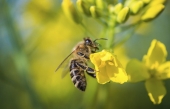
 1
1












Max Menchaca wrote:I've found some previous discussion here, which praises catching a swarm. It sounds like a good idea, but you also have no guarantee where the bees are coming from (what their toxic load or mite load might be). What do all of you think?
I am only one, but still I am one. I cannot do everything, but still I can do something; and because I cannot do everything, I will not refuse to do something that I can do. (E.E.Hale)




Max Menchaca wrote:I've found some previous discussion here, which praises catching a swarm. It sounds like a good idea, but you also have no guarantee where the bees are coming from (what their toxic load or mite load might be). What do all of you think?
find religion! church
kiva! hyvä! iloinen! pikkumaatila
get stung! beehives
be hospitable! host-a-hive
be antisocial! facespace




tel jetson wrote:
Max Menchaca wrote:I've found some previous discussion here, which praises catching a swarm. It sounds like a good idea, but you also have no guarantee where the bees are coming from (what their toxic load or mite load might be). What do all of you think?
swarms are helpful for varroa because they cause a break in the brood cycle. varroa mites need brood to reproduce. if there's no brood for a while, as is the case for a newly hived swarm, varroa reproduction is interrupted and the population drops. conveniently, this is the case for both the swarm and the colony that issued the swarm.












Jessa Hunt wrote:I'm going to be trying the Small Cell foundation method. Bees have been bred bigger than nature intended, and kept that way by commercial frame foundation making brood cells about 5.4mm. Small Cell is 4.9mm, and I've seen people post success with handmade foundation of 4.8. The idea is that varroa has a harder time in the smaller brood cells than in the big ones. Part of why a lot of people put in a sacrifice frame of drone sized foundation to pull out and freeze after its capped, because the varroa still prefer the bigger drone brood. They are so destructive because they CAN use regular worker brood to multiply. But in theory, the smaller, more natural sized bees and cells cut down on the varroa populations.
I've seen arguments for and against small cell, but I figure its worth a shot.





Jessa Hunt wrote:I've seen arguments for and against small cell, but I figure its worth a shot.




Mac Harkaway wrote:
I have found that the information here:
http://scientificbeekeeping.com/
and especially here:
http://scientificbeekeeping.com/extended-release-oxalic-acid-progress-report-4/
I am only one, but still I am one. I cannot do everything, but still I can do something; and because I cannot do everything, I will not refuse to do something that I can do. (E.E.Hale)





|
Try 100 things. 2 will work out, but you will never know in advance which 2. This tiny ad might be one:
The new purple deck of permaculture playing cards
https://www.kickstarter.com/projects/paulwheaton/garden-cards
|









